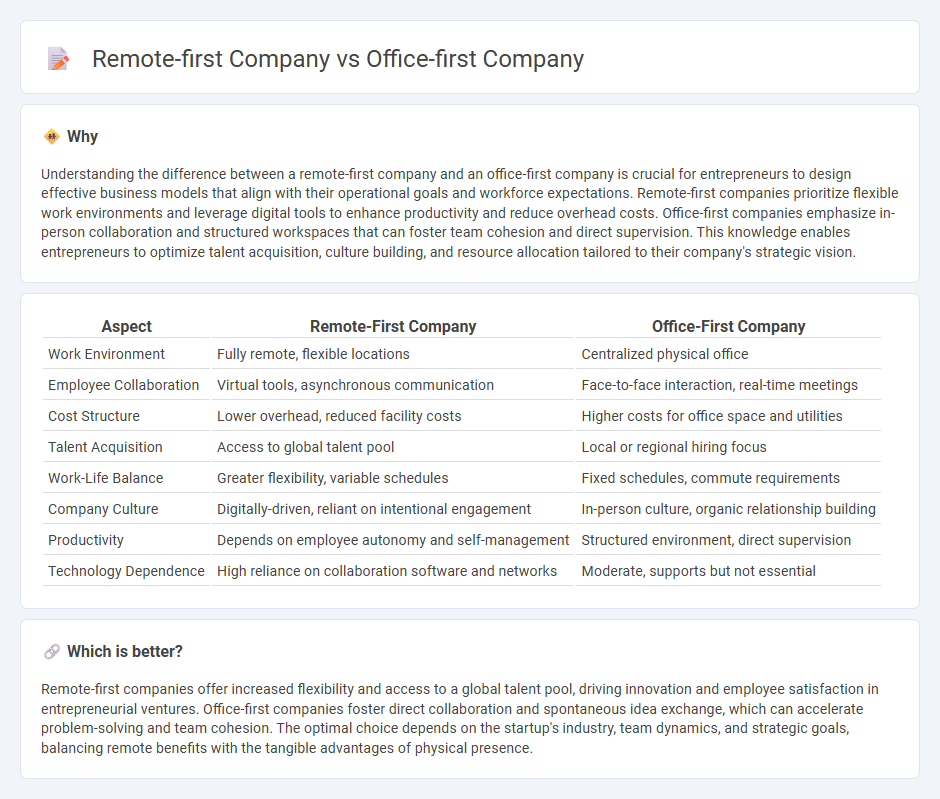
Remote-first companies leverage digital tools to foster flexible work environments, increasing employee satisfaction and access to global talent pools, while office-first companies emphasize in-person collaboration to enhance team cohesion and real-time communication. Studies show remote-first models can reduce operational costs by up to 30%, whereas office-first setups may benefit from stronger company culture through face-to-face interactions. Explore more about how these approaches impact productivity and business growth.
Why it is important
Understanding the difference between a remote-first company and an office-first company is crucial for entrepreneurs to design effective business models that align with their operational goals and workforce expectations. Remote-first companies prioritize flexible work environments and leverage digital tools to enhance productivity and reduce overhead costs. Office-first companies emphasize in-person collaboration and structured workspaces that can foster team cohesion and direct supervision. This knowledge enables entrepreneurs to optimize talent acquisition, culture building, and resource allocation tailored to their company's strategic vision.
Comparison Table
| Aspect | Remote-First Company | Office-First Company |
|---|---|---|
| Work Environment | Fully remote, flexible locations | Centralized physical office |
| Employee Collaboration | Virtual tools, asynchronous communication | Face-to-face interaction, real-time meetings |
| Cost Structure | Lower overhead, reduced facility costs | Higher costs for office space and utilities |
| Talent Acquisition | Access to global talent pool | Local or regional hiring focus |
| Work-Life Balance | Greater flexibility, variable schedules | Fixed schedules, commute requirements |
| Company Culture | Digitally-driven, reliant on intentional engagement | In-person culture, organic relationship building |
| Productivity | Depends on employee autonomy and self-management | Structured environment, direct supervision |
| Technology Dependence | High reliance on collaboration software and networks | Moderate, supports but not essential |
Which is better?
Remote-first companies offer increased flexibility and access to a global talent pool, driving innovation and employee satisfaction in entrepreneurial ventures. Office-first companies foster direct collaboration and spontaneous idea exchange, which can accelerate problem-solving and team cohesion. The optimal choice depends on the startup's industry, team dynamics, and strategic goals, balancing remote benefits with the tangible advantages of physical presence.
Connection
Remote-first and office-first companies are connected through their shared goal of optimizing productivity and employee engagement in entrepreneurship. Both models leverage technology and management strategies to foster innovation, collaboration, and business growth, despite differing in physical workspace priorities. Hybrid approaches often emerge, blending remote flexibility with office presence to balance operational efficiency and company culture.
Key Terms
Workplace Flexibility
Office-first companies prioritize in-person collaboration, requiring employees to work primarily on-site, which fosters direct communication and structured routines but may limit flexibility. Remote-first companies emphasize flexibility by enabling employees to work from various locations, leveraging digital tools for seamless virtual collaboration and promoting work-life balance. Discover how adopting either model can transform workplace culture and productivity.
Collaboration Tools
Office-first companies typically rely on physical meetings supported by tools like Microsoft Teams and Zoom for hybrid interactions, emphasizing seamless in-person collaboration. Remote-first companies prioritize cloud-based platforms such as Slack, Asana, and Miro to facilitate real-time communication and project management across dispersed teams. Explore how these collaboration tools impact productivity and team dynamics in different work models.
Talent Acquisition
Office-first companies often emphasize local talent pools, relying heavily on in-person interviews and on-site assessments to gauge candidate compatibility. In contrast, remote-first companies leverage global talent markets, utilizing digital tools for virtual recruitment processes and embracing flexible work arrangements to attract diverse skill sets. Explore the nuanced strategies each approach employs to optimize talent acquisition in today's competitive job market.
Source and External Links
Company - OFFICEFIRST - OFFICEFIRST Real Estate GmbH is a leading office-first company in Germany, managing over 70 office properties and around 1.3 million sq m of office space across key cities with a strong focus on asset management and value-added services.
OFFICEFIRST Real Estate GmbH - This company specializes in the management, development, acquisition, and sale of office properties in Germany, with a large portfolio and numerous offices in major cities, offering top-tier office asset management services.
OFFICE FIRST Brand Relaunch - Koln - substance id - OFFICE FIRST, part of Blackstone Group, is a major German asset management platform focused on office real estate, managing a substantial portfolio and emphasizing quality and professionalism in its brand and operations.
 dowidth.com
dowidth.com